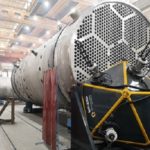22/10/19
Based in Hartmannsdorf (Saxony, Germany), Metrom is combining its remarkable machine tools with 3D-printing technology from the likes of Fraunhofer IWU. In doing so, it hopes to create new additive applications.
At Formnext 2019, Metrom and Fraunhofer IWU want to set a new world record by achieving a printing speed of 1.2 meters per second.
At Metrom’s production facility in Hartmannsdorf, the inventiveness for which the state of Saxony is known is bearing fruit that is equal parts innovative and extraordinary. One such breakthrough resembles the hemispherical dome of a small radar station, but with protruding, spider-like legs of steel that pivot and swing in a mysterious rhythm around a single point of focus. Through a small window in the dome, you can see how the legs move a drive spindle and milling tool that are giving a precise shape to a metal component more than a meter in diameter.
This unique machine tool is based on something called pentapod technology, which Metrom founder Dr. Michael Schwaar developed some 20 years ago. In essence, it involves five multidirectional ball screws that move a spindle into the necessary positions. As if that weren’t remarkable enough, Metrom has now married its pentapod technology to various additive manufacturing techniques, as well.
“We didn’t want to limit ourselves to the usual market for machining centers, so we asked ourselves how else we might leverage the wide-ranging potential of our machine,” explains Susanne Witt, daughter of Dr. Schwaar and Metrom’s current managing director. “Our technology can move a lot more than a spindle, after all.” Along with her husband, Marcus Witt (who directs the company’s technical sales activities as CTO), the 39-yearold industrial engineer thus began searching for suitable partners – and found two of them in Berlin’s Gefertec and the Fraunhofer Institute for Machine Tools and Forming Technology (IWU) in nearby Chemnitz
Successful cooperation between Metrom and the Fraunhofer IWU in Chemnitz: Marcus Witt, Susanne Witt, Christopher John (first row from left), Tobias Clauß, Martin Kausch, Johannes Blase (back row from left).
Thanks to the success of its resulting cooperative projects, Metrom and its 15 employees can now offer machines that use interchangeable modules to 3D-print both synthetics and metal (by means of overlay welding) and create objects up to two cubic meters in size. The company says that the machines are even capable of six cubic meters under certain conditions. Simply switching tools makes intermediate and post-processing possible via milling and drilling without having to reclamp the workpiece. »By combining additive and subtractive methods, we’re opening up new possibilities in numerous fields of application,« Marcus Witt states. Another special feature of this flexible, five-axis hybrid machine tool is its mobility, which makes it possible to repair things like power plant turbines right where they operate.
The print head Metrom’s machine uses for synthetic production was developed by the aforementioned Fraunhofer IWU. The 40-kilogram extrusion unit, which leverages SEAM (Screw Extrusion Additive Manufacturing) technology, is capable of using standard granulate. This results in much lower material costs compared to conventional FDM and FLM techniques according to Christopher John, who oversees the corresponding project at the institute. Its patented bypass nozzle also makes the output volume fully variable, from zero to 100 percent. This means that the printing process ” can be stopped and then restarted after a change in position. At the same time, the print head can also produce thin-walled objects. It offers yet another advantage when paired with Metrom’s pentapod machine: »It produces round and angular wall shapes and stabilizing partitions in a continuous process, which takes very little time,” John explains. He adds that a wide array of applications are possible, from clamping devices for CFRP components to uses in automotive production. According to John, all of these operations can be performed at a high processing speed, which is why Metrom and Fraunhofer IWU are hoping to do more than just present their new technology at Formnext 2019 (at a shared booth hosted by IHK Chemnitz). John has already announced their intention to “set a new world record by achieving a printing speed of 1.2 meters per second” – that’s at least four times faster than other current methods. It would also make a myriad of new applications more cost-effective in industrial settings.

For Susanne Witt, the way in which additive technologies have played a prominent role in the ongoing development of Metrom’s machines has to do with the »different level of imagination« customers are now exhibiting. »We used to have to explain a lot about 3D printing and make an effort to win companies over,« she recalls. »These days, they’re the ones coming to us with their requests.« In that respect, her company’s new innovative focus has aligned optimally with the increased acceptance of additive manufacturing.
Indeed, the years ahead could usher in further fields of application that Metrom and Fraunhofer IWU have not even begun to consider today. »For a special-purpose mechanical engineering company like ours, developments are always driven by customers,« Susanne Witt points out. »It’s ultimately the customer who determines our direction,« affirms Christopher John.
FON MAG Formnext Magazine – Text: Thomas Masuch – Photos: Metrom – 2019/09/09